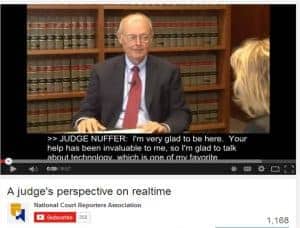By Tammy Jaffe
For five-and-a-half years I lived what I would call basically one great big court reporting adventure. I had moved to New Orleans from Phoenix to become a maritime and oil and gas reporter, except the thing about that move was that I had no idea what being a “maritime and oil and gas reporter” meant.
For my first assignment onboard a ship, not a single sole at the agency mentioned how important it was to wear blue jeans to the dock — hence, before attempting to maneuver across the rope ladder, I had to hold my skirt and steno machine with one hand, and the rope ladder the other, and make my way aboard ship on a rope ladder wearing high heels.
But that was a piece of cake compared to one assignment I’ll never forget. We all caught a commercial flight to Minneapolis/St. Paul, where we all then climbed into a large car and drove to a lock. Once there, we were ushered to the area where the pushboat was waiting. That was the first time I’d ever seen a ladder that high. It had to be at least 50 or 60 feet high, and we each had to climb down holding our briefcases in one hand and the ladder in the other. Unfortunately, no one had warned us in advance about this climb! One attorney who was deathly afraid of heights nearly caused us to miss the boat completely due to his hands needing to be pried by one person on top while spotted by another person below.
Eventually we all made it down to the pier, even the acrophobic counselor. Once there, even more fun was had, as we each had to throw our briefcases to a deckhand, who then laid each case down and tried to steady each of us after we’d jumped from the pier onto the pushboat to be sure none of us went down. From the deck, we still had to climb up two short ladders to get to the bridge, where the captain sat. Once there, all counsel stood throughout the examination, as there was only one chair besides the captain’s, and counsel graciously acquiesced and let me take that.
Once we were all nicely squished onto the bridge, the boat began moving, which meant the engines were turned on full throttle. If you’ve ever been on the bridge of a pushboat with the engines going full throttle, you know that hearing human voices is even trickier than getting onto the bridge. By the time all counsel had sufficiently examined the captain and we had pulled into the next dock to disembark, everyone was hoarse, and everyone had a headache, so we all went out to celebrate the fact that we’d managed to get through this deposition without injury or permanent hearing loss.
The strangest part of the entire assignment occurred after our dinner celebration, when we’d all caught our plane back to New Orleans, and we each went back to our personal cars. As all counsel got into their cars and drove off, I realized that my car wasn’t there. In its exact spot, however, where I’d parked it that morning, stood orange cones and torn up asphalt roped off by construction tape.
Counsel thought immediately that perhaps I’d imbibed one too many drinks during our celebratory meal; but I’ve always been a 2-drink-max-kind-of-girl, so I knew what I was talking about. After quite a bit of prodding, counsel drove me to the lot attendant at the ticket booth, and when I inquired as to the whereabouts of my car and all the other cars that were parked where the orange cones were standing, he responded coolly, “All them cars was towed down to the long-term lot, don’t cha know.” At that point, counsel couldn’t help himself. He began laughing uncontrollably, told me to “get back in the car,” and drove me to the long-term lot, where I eventually was reunited with my little red car.
After I left New Orleans and moved to Washington, D.C. to embark upon my East Coast reporting career, I discovered how really lucky I was to have had the opportunity to live that crazy maritime reporter life — those were the days!

 U.S. District Court Judge David Nuffer tells listeners
U.S. District Court Judge David Nuffer tells listeners